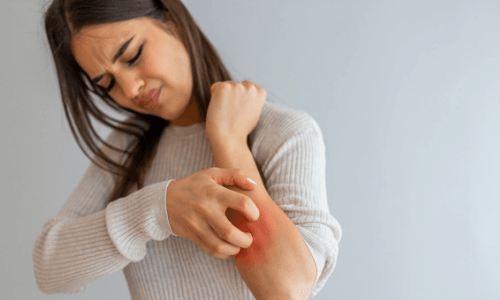It is widely known that The Sandalwood Shop customers often flock to our flagship pure essential sandalwood oils first, but did you know that our Mt Romance Skin Damage Control is just as popular? A soothing all-natural ointment consisting of a powerful blend of complementing essential active botanicals: Australian sandalwood, peppermint, tea tree and clove.
Our Mt Romance Skin Damage Control is specially designed for mitigating skin irritations, often caused by environmental conditions, such as harsh weather conditions. In fact, some long-time customers have happily used our ointment for treating a variety of skin ailments, including inflammations caused by scratching. The botanicals found within our Mt Romance Skin Damage Control works to sooth the area, providing long enough relief that the person is likely to feel less of a need to scratch or pick. Further, it is also beneficial for mosquito bites, minor scratches, cracked heels, blemishes and even cuticle care! It is a wonder that our customers all flock to this product when it comes to skin irritation. Now let's explore the botanicals that make up this product a little further......

Sandalwood
Sandalwood's natural affinity with the skin and its ability to resolve skin conditions, is known the world over and across all cultures. It is also the ingredient of choice by Indigenous Australians when it comes to healing, spirituality, and sustenance. For centuries, it has been popular topically to alleviate inflammatory skin conditions and even body aches!
Peppermint
This highly aromatic plant is a hybrid mint, a blend of watermint and spearmint, its botanical name is Mentha piperita. Commonly used for calming the skin irritation and itchiness by reducing skin inflammation and redness. So much so that a recent study on peppermint oil has found that topical treatment of “……chronic pruritus with peppermint oil is effective, easy to use, safe, cheap, and more acceptable”. (Elsaie etal, 2016, p.337) Seeing that ‘pruritus’ is typically described as continued itchiness, where the person is triggered to scratch due to sensation of the skin. This is significant because it’s the continued scratching that prevents the skin from healing. (Elsaie et al, 2016)
Tea Tree
Melaleuca alternifolia, a tall shrub in the Myrtaceae family is incredibly well recognised for its ‘cleansing’ properties and invigorating scent. A natural antiseptic, antiviral and fungicidal agent, traditionally used by the Bundjalung Aborigines of northern New South Wales, where crushed leaves were “……inhaled to treat coughs and colds or sprinkled on wounds, after which a poultice was applied……”. Infusions of tea tree were even made to treat sore throats or skin conditions. (Carson C.F et al, 2006, p.52)
Clove
Distilled from the flower buds of Eugenia caryophyllus, clove oil is best known for its anti-microbial and antioxidant properties. Therefore, it’s not surprising that the top three usages of clove essential oil are for treating infections, dental applications and skin care. The main active constituent, eugenol has magnificent rejuvenating and stimulating properties, for instance it can promote blood circulation, which not only aids healing, but it is also incredibly beneficial to the skin. So much so that clove is extremely popular in creams for improving the effects of aging such as wrinkles and blemishes.
Indeed, our Mt Romance Skin Damage Control is useful for a myriad of applications. Its critical success factor can be argued to be the synergistic effects of the above four amazing essential oils. Healthy skin is not an overnight process but a reflection of our overall wellness. We hope this article has enlighten you a little bit more on why we chose the ingredients we do when formulating our products.
Julian, B, What Is It, Causes, Types, Treatments, and More, Osmosis from Elsevier, viewed 12th May 2022, < Pruritus: What Is It, Causes, Types, Treatment, and More | Osmosis>
Elsaie L.T, El Mohsen, A. M., Ibrahim, I. M., Mohey-Eddin, M. H., & Elsaie, M. L, “Effectiveness of topical peppermint oil on symptomatic treatment of chronic pruritus.” Clinical Cosmetic and Investigational Dermatology, Oct 2016, Vol(9), p.333-338 Doi:10.2147/CCID.S116995
Carson C.F, Hammer K.A & Riley T.V, ““Melaleuca alternifolia (Tea Tree) oil: a review of antimicrobial and other medicinal properties.” Clinical Microbiology Reviews, 2006, Vol(19)1, p.50-62 Doi:10.1128/CMR.19.1.50-62.2006

